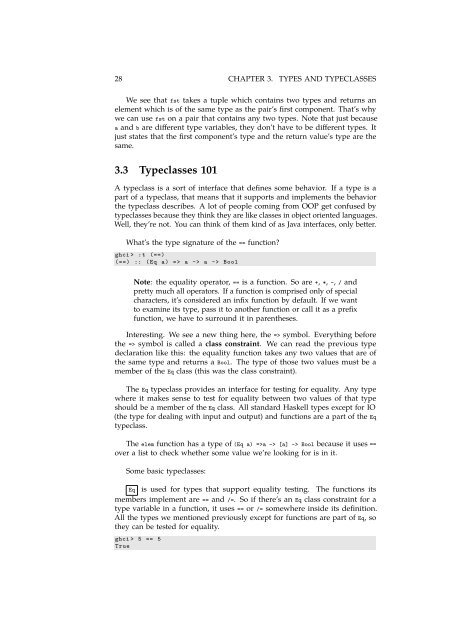Create successful ePaper yourself
Turn your PDF publications into a flip-book with our unique Google optimized e-Paper software.
28 CHAPTER 3. TYPES AND TYPECLASSES<br />
We see that fst takes a tuple which contains two types and returns an<br />
element which is of the same type as the pair’s first component. That’s why<br />
we can use fst on a pair that contains any two types. Note that just because<br />
a and b are different type variables, they don’t have to be different types. It<br />
just states that the first component’s type and the return value’s type are the<br />
same.<br />
3.3 Typeclasses 101<br />
A typeclass is a sort of interface that defines some behavior. If a type is a<br />
part of a typeclass, that means that it supports and implements the behavior<br />
the typeclass describes. A lot of people coming from OOP get confused by<br />
typeclasses because they think they are like classes in object oriented languages.<br />
Well, they’re not. You can think of them kind of as Java interfaces, only better.<br />
What’s the type signature of the == function?<br />
ghci > :t (==)<br />
(==) :: (Eq a) => a -> a -> Bool<br />
Note: the equality operator, == is a function. So are +, *, -, / and<br />
pretty much all operators. If a function is comprised only of special<br />
characters, it’s considered an infix function by default. If we want<br />
to examine its type, pass it to another function or call it as a prefix<br />
function, we have to surround it in parentheses.<br />
Interesting. We see a new thing here, the => symbol. Everything before<br />
the => symbol is called a class constraint. We can read the previous type<br />
declaration like this: the equality function takes any two values that are of<br />
the same type and returns a Bool. The type of those two values must be a<br />
member of the Eq class (this was the class constraint).<br />
The Eq typeclass provides an interface for testing for equality. Any type<br />
where it makes sense to test for equality between two values of that type<br />
should be a member of the Eq class. All standard Haskell types except for IO<br />
(the type for dealing with input and output) and functions are a part of the Eq<br />
typeclass.<br />
The elem function has a type of (Eq a) =>a -> [a] -> Bool because it uses ==<br />
over a list to check whether some value we’re looking for is in it.<br />
Some basic typeclasses:<br />
Eq is used for types that support equality testing. The functions its<br />
members implement are == and /=. So if there’s an Eq class constraint for a<br />
type variable in a function, it uses == or /= somewhere inside its definition.<br />
All the types we mentioned previously except for functions are part of Eq, so<br />
they can be tested for equality.<br />
ghci > 5 == 5<br />
True



